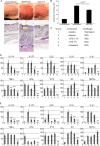Development of a Topical Treatment for Psoriasis Targeting RORγ: From Bench to Skin
- PMID: 26870941
- PMCID: PMC4752338
- DOI: 10.1371/journal.pone.0147979
Development of a Topical Treatment for Psoriasis Targeting RORγ: From Bench to Skin
Abstract
Background: Psoriasis is a chronic inflammatory skin disorder involving marked immunological changes. IL-17-targeting biologics have been successful in reducing the disease burden of psoriasis patients with moderate-to-severe disease. Unfortunately, the stratum corneum prevents penetration of large molecule weight proteins, including monoclonal antibodies. Thus, for the majority of psoriasis patients ineligible for systemic treatments, a small molecule targeting RORγt, the master regulator of IL-17 family cytokines, may represent an alternative topical medicine with biologic-like efficacy.
Methods and findings: The preclinical studies described in this manuscript bridge the gap from bench to bedside to provide the scientific foundation for a compound entering clinical trials for patients with mild to moderate psoriasis. In addition to several ex vivo reporter assays, primary T cell cultures, and the imiquimod mouse model, we demonstrate efficacy in a newly developed human ex vivo skin assay, where Th17-skewed cytokine expression is induced from skin-resident immune cells. Importantly, the skin barrier remains intact allowing for the demonstration of topical drug delivery. With the development of this novel assay, we demonstrate potent compound activity in the target tissue: human skin. Finally, target engagement by this small molecule was confirmed in ex vivo lesional psoriatic skin.
Conclusions: Our work describes a progressive series of assays to demonstrate the potential clinical value of a novel RORγ inverse agonist small molecule with high potency and selectivity, which will enter clinical trials in late 2015 for psoriasis patients.
Conflict of interest statement
Figures





References
-
- Bowcock AM, Krueger JG (2005) Getting under the skin: the immunogenetics of psoriasis. Nat Rev Immunol 5: 699–711. - PubMed
-
- Zheng Y, Danilenko DM, Valdez P, Kasman I, Eastham-Anderson J, et al. (2007) Interleukin-22, a T(H)17 cytokine, mediates IL-23-induced dermal inflammation and acanthosis. Nature 445: 648–651. - PubMed
Publication types
MeSH terms
Substances
Grants and funding
LinkOut - more resources
Full Text Sources
Other Literature Sources
Medical
Molecular Biology Databases
Miscellaneous

